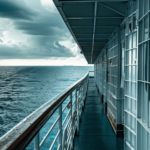When it comes to vacations, many people will kill for the chance to take a cruise. But for some individuals, travel can be difficult – especially if you’re prone to motion sickness. If you’re feeling queasy on your next cruise, don’t worry, we’ve got you covered. In this article, we’ll discuss the best ways to prevent motion sickness on a cruise ship and give you some cruise motion sickness tips. Ready to sail away without any worries? Let’s get started!
Do most people get motion sick on a cruise?
Cruise ship travel is becoming increasingly popular, and for a good reason. Not only are cruise ships luxurious and comfortable, but they also offer some of the best views anywhere. However, there is one potential downside to cruising: motion sickness.
A recent study found that 15% of people experience seasickness while onboard a cruise ship. This number jumps to as high as 30% among those on multiple cruises. Why do so many people get sick on these trips?
One theory suggests that constant movement makes it harder for your body to adjust to its new environment. Other factors that may contribute to this include:
- Being in an enclosed space with a closed atmosphere.
- Eating foods high in salt (sailors often eat salty snacks and meals).
- Drinking alcohol or taking medications that cause drowsiness or nausea.
If you’re concerned about getting sick during your next trip, take precautions beforehand by reading up on seasickness symptoms and avoiding things that make you nauseous or dizzy. Also, remember to bring medication with you if needed, and drink plenty of fluids throughout your voyage.
What is the best place on cruise ship to avoid motion sickness?
If you plan to cruise this season, be prepared for some motion sickness! Cruise ships move around a lot, and it can be tough to avoid feeling seasick. However, there are several things that you can do to reduce your chances of getting sick:
– Choose a stateroom in the middle of the ship on a lower deck. This is usually the best location on cruise ship for motion sickness, which will minimize the movement you experience during your voyage.
– Drink plenty of fluids (especially if you’re prone to dehydrating), and take antinausea medications before boarding the ship.
– Be patient. Motion sickness usually worsens during the first few days at sea and eventually subsides. Don’t try to rush through your trip to get rid of nausea as quickly as possible; it’s more likely that you’ll only make it worse by doing so.
– Avoid eating foods that are high in salt or sugar before sailing; these items may increase your risk of developing seasickness.
– If you’re vomiting, drink a lot of water, avoid caffeine, exercise regularly during the voyage, and rest when possible.
By following these tips, you should be able to manage your symptoms without resorting to medication or doctor visits.
How are you preventing motion sickness on a cruise?
Motion sickness is a serious problem that can affect anyone, even those who are typically relatively immune to seasickness. You can follow a few tips if you want to enjoy your cruise without feeling ill.
The first step is to avoid exposure to the sea during the early stages of your voyage. This means avoiding boarding the boat and getting on board as soon as possible. It’s also important to refuse drinking alcohol or eating large meals before heading out on the water. These activities will increase your chances of becoming sick later in the trip.
Once onboard, make sure you take frequent breaks throughout the voyage. This will help reduce overall stress levels and keep your body functioning at its best under adverse conditions. In the end, be prepared for anything by taking along appropriate medications (prescription or over-the-counter) if needed. Once you follow these simple guidelines, you’ll be able to sail away nausea free.
What is a good motion sickness remedy for cruise?
Many guests turn to medication such as Dramamine or Bonine to help them fight motion sickness on cruise ships. But there is no one-size-fits-all answer to this question. The best remedy for each individual may vary depending on their symptoms and the type of ship they are traveling on.
Some people find that Dramamine helps reduce nausea and vomiting, while others find that it makes them tired. For those who experience more severe symptoms, Bonine can be a safer option because it doesn’t have any side effects other than causing a mild headache in some cases.
Remember: always consult your doctor before taking any medications if you are unsure whether they will interfere with any prescription medications you are taking or cause further health complications.
What naturally helps with motion sickness?
Motion sickness is a common problem on cruise ships, and there are many ways to minimize it. Some of the most popular methods include drinking ginger ale or chewing on ginger candies or gummi bears. Ginger also has anti-inflammatory properties, which may contribute to its effectiveness against seasickness symptoms. On the other hand, peppermint tea is one of the best natural remedies for motion sickness.
Peppermint is a natural decongestant that helps relieve symptoms such as dizziness, nausea, and abdominal pain. Drinking peppermint tea before sailing can help reduce your chances of getting sick by soothing your stomach and helping you avoid seasickness. Some people also find that chewing on a piece of candy or drinking mints helps keep their stomach settled while on a cruise ship.
So if you’re anticipating any problems with motion sickness during your cruise, make sure to drink a cup of peppermint tea.





